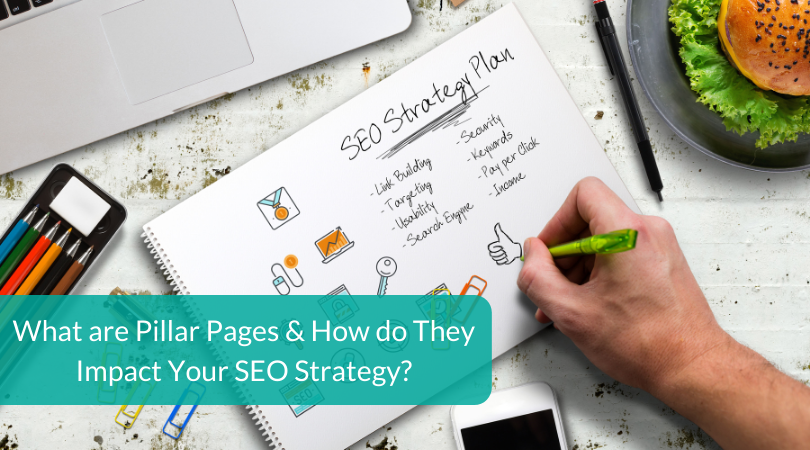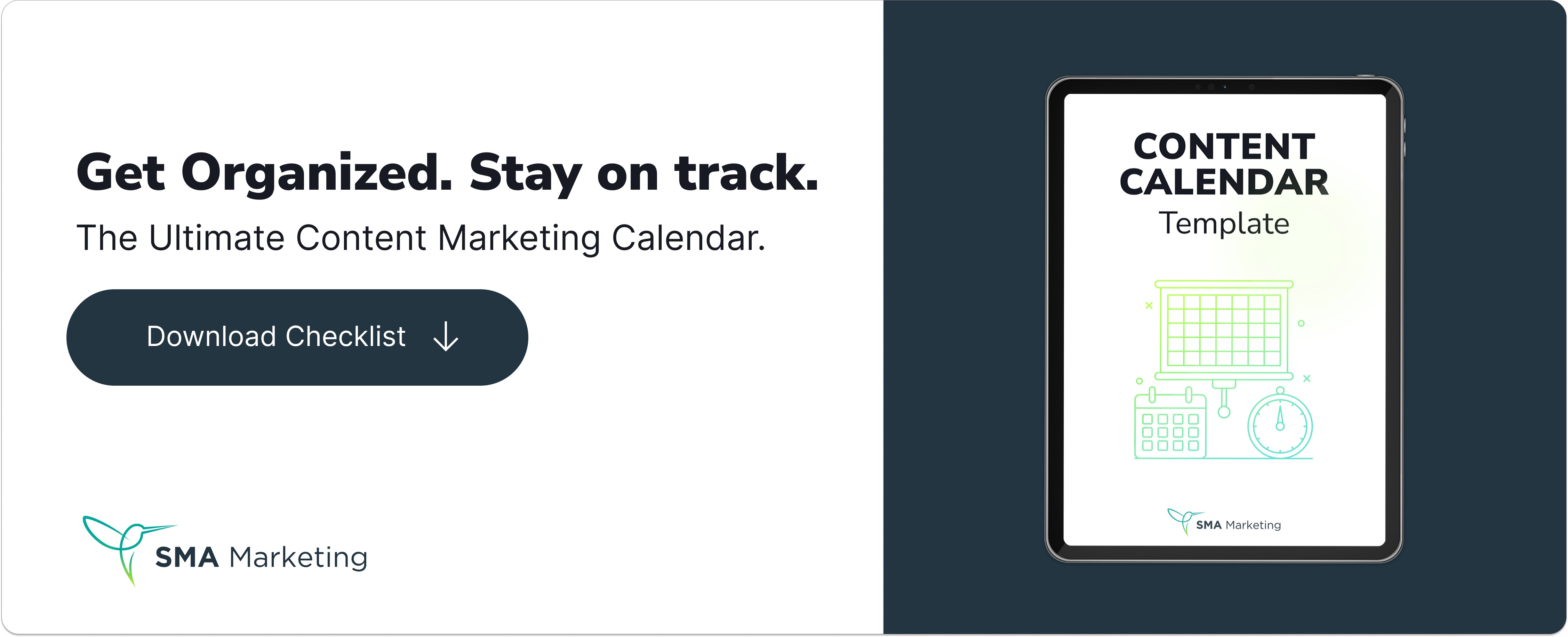
When it comes to growing your organic visibility and position, your company as an
What is a Pillar Page?
A pillar page is a piece of website content that covers a broad topic in depth. All aspects of the topic are covered on a single website page and more detailed related content is covered on blogs linked to the pillar page. This forms content clusters and the cluster content structure is the foundation of topic-based SEO.

Topic-Based SEO – Pillar Page and Topic Cluster Example
The idea of a pillar page, or what I’ve always called a core page, is to increase your topic authority by creating an in-depth piece of pillar content that covers as many aspects of a specific broad topic as possible. Brian Dean has been using the strategy to create content pillars with great success for years. To see an example of one of Brian Dean’s pillar pages here.
As you see in Brian Dean’s content pillar example, it includes a ton of high-quality content, broken into multiple sections (chapters). But the idea is to give as much information as you can around a topic to show your authority to your users and the search engines.
Pillar page content doesn’t happen by accident. Building pillar pages into your content marketing strategy takes a lot of time and careful planning and execution. Check out the video below to learn what pillar pages are and how they impact your content marketing and SEO strategies.
Video Transcript:
Hey, thanks so much for checking out this video. If this is your first time watching, I want to say welcome. If you’ve been watching a while, hey, welcome back. If you haven’t yet subscribed, please hit the button to subscribe now. We would love to have you join our community.
Over the last couple of years, or maybe a year and a half or so, HubSpot has been pushing something known as pillar pages. HubSpot is an inbound marketing software used to get everything that you need to do to achieve high-level inbound marketing under one roof. Now, they’ve been pushing pillar pages for one main reason. Google is focused on topic authority. This is nothing new. This is something that we’ve known about for quite some time. They’ve been really gearing towards this in order to better understand user intent and to deliver the content that a user is expecting, that’s actually going to answer their questions.
What’s the difference between topics and keywords?
To understand the difference between topics and keywords, think of topics as the meta-category. The top category. The big thought. We can have a topic like SEO. Let’s say we have this topic. Now, this is our big idea. This is something that we want to be known for, something that we want to do. Underneath this, we are going to have relevant content related to SEO, such as local SEO or search marketing. We’re going to have relevant topics like Google and semantic SEO. These are all keywords and terms that are now related to this meta topic, which we could use as a main pillar page topic.
In Google, when they’re looking for authority figures on ideas, they want to know that you’re a topic expert. Yes, you want to be a niche expert as well and maybe this is going to be your focus over here. Then, there’s going to be subcategories under there. What they’re looking for, is do you know what you’re talking about. One of the ways that they do that, is they look at the content in the entire topic cluster. They look to see whether or not your keywords and the content that you’re writing about matches the topic authority of what you’re talking about.
Where do pillar pages fit into a topic-based SEO strategy?
Since Hummingbird was released and Google began to focus more on topics and more on relational search or search that’s more contextual, we have been focusing our SEO strategies on our services pages, on what we would call our core page, which is the exact same thing as a pillar page. These are pages that prove your topic authority and help the user better understand. A pillar page is not really a high-level piece of content at the top of the funnel. It’s more in that consideration stage, more in the middle of the buyer’s journey. It’s going to add a lot more context. It’s also going to help that user take the next step into building that relationship with you.
What you want to do is have these pages on your site that display topic authority and then you want to build relationships between those pages and other related pieces of content such as blog posts. Let’s take a look at how the pillar page topic-based SEO strategy works.
Building out topic clusters from pillar pages
If you’ve got a website, you’ve got a number of pages. Right? You’ve got your home page, about, services, and content. Underneath your services pages, you’re going to have probably what you’re known for. I’m just going to use what we do as an example because it’s going to be easier for me and I hope it still makes sense to you. We’ve got SEO, we’ve got inbound, and we’ll also say analytics.
Now, we can treat either our services pages as core pages, or we can build a separate pillar page. What a pillar page would be, would be something like you’ve probably seen like the Ultimate Guide to SEO. What this guide is going to be is a really in-depth piece of content that covers everything about SEO from on-page to off-
It doesn’t just stop there. We don’t just create one page on a pillar topic. Now, we’ve got to take this page and build relationships between our site pages, because we’re going to be doing this with each one of our core pages here. Then, Google now wants to see
Let’s talk a little bit about how that all flows together. So, you’ve created this pillar page and you’ve created this really in-depth piece of content that you want to ultimately drive your users to. A pillar page’s goal isn’t to drive people to your blog content, it’s to move people deeper into that page and hopefully take some action. This can be your pillar page.
Now, what you want to do is start driving traffic or start to show relationships to it. Again, let’s say this one is about SEO again. Now, I might have a blog article that is an SEO how to. I want to add an internal link from this SEO how to blog post to the pillar page. Maybe I’ve got one on local SEO. Again, I want to add an internal link to that. I also maybe have one on backlinks. I want to add an internal link back to that. What this is doing is starting to create a web. Go figure, right? Where Google is able to crawl our sites and begin to see the relationship. Not just the content on this page, but that we also have other authoritative pieces of content on our website. Now, what we also need to do is take these pages and, if appropriate, interlink them where it makes sense. Again, we’re showing that relationship. We also want to find high-quality third-party sites that we can build relationships with that can also build backlinks to these pages.

Pillar Pages and Topic Clusters
That is going to raise the visibility of these blog pages. Building out pillar pages and linking the content within topic clusters will increase the authority of the blog pages in this content cluster, which then is going to pass that authority to the pillar page as well. Alone, this pillar page should be attracting tons of links as well. If it is a really good piece of content and it’s being marketed well and distributed well, it’s going to increase in value which in return has the potential to increase the value of all your other related content.
Distribute your pillar page content on relevant marketing channels
Topic-based SEO really starts to work in a very cyclical way and the pages need to be integrated with your overall SEO and content marketing strategies. You can’t just put one page up and spend a lot of time creating this content and hope that people are going to find it and link to it. You may have people on social. Great. Push it out to social. Use it in your newsletter, but make sure you’re distributing your content on all the relevant marketing channels. Make sure that the technical side of it is done right, that the content is well written, that it’s easy to read, that it’s digestible, that it’s contextual, and then make sure that you have the links in place.
This is a critical piece of this strategy and it’s how the topic cluster model works. A lot of people don’t do it because it’s hard and it does take time to build out topic clusters. It takes a lot of organization and understanding what are these types of sites that you should be linking to. Not all links are created equal. You can spend a lot of time and a lot of money buying or going after bad links that are actually going to do the opposite of what you want the strategy to do for you.
Make sure that you take the time to not just identify what you want to create that core pillar page about, but what are the other assets you have that you can interlink and begin to build this web. What resources can you build outside of that? Maybe you can do some guest posting, get some resource pages, maybe you find some high-quality niche communities in LinkedIn, or some other places, where you can begin to build in some of these links and these other assets and traffic that are going to build the credibility of your pages, which is going to allow those pages to rank better. Rank is not everything, but it still matters. There are more opportunities now than ever with the way that Google is working using rich snippets and a lot of other things inside of the SERPs.
We have a lot of SERP features now that we have access to by creating content that’s very high quality and answers your audience’s specific search queries. Using pillar pages and topic clusters in your SEO and content strategy improves your chances of getting in front of your prospective customers and really driving them towards connecting with your business and building that relationship.
Again, the goal of the pillar page isn’t just traffic. It’s to improve your user experience and to educate your audience on your core topics. Ultimately, it will lead them further down the buyer’s journey so that they can make an informed decision about whether or not to do business with you.
If you have any questions, I would love to continue the conversation. Comment below or shoot us an email. We would love to continue this conversation. Until next time, Happy Marketing.
Editor’s Note: This article was originally published in July 2018 and has been updated with fresh content.

Source link



